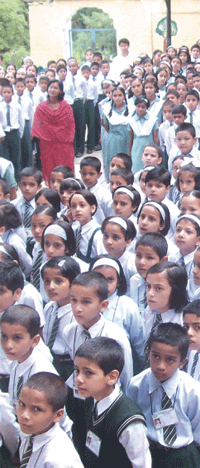

How do teachers, administrators and policy makers feel about their experiences with technology? Is there a balance between teaching about technology as a subject, and as a tool for learning? Has the technology integration proved financially, technically and administratively sustainable over time?

In continuation to our discussions on formulating a National Policy on ICT in School Education in India, and our attempt to make the discussions more wide, open and collaborative, we are producing the discussions that the UN Solution Exchange (www.solutionexchange-un.net.inen) Community members have reflected on the key thematic pillars like ICT Infrastructure, e-Content, Capacity Building, Innovation and Research, Monitoring and Evaluation, Quality in School Education, and Public
Private Partnerships in a series. In this issue, we are presenting a part of the discussions happened on the issue of Public Private Partnership. The July issue of Digital Learning has produced the e-Discussions of the UN Solution Exchange Education and Development community on the e-Content.
As we know, the Ministry of Human Resource Development (www.education.nic.in), Government of India, has already initiated the process to formulate the ‘National Policy on ICT in School Education’. The Global e-Schools and Communities Initiative (www.gesci.org), a UN ICT Task Force founded organisation, along with Centre for Science, Development, and Media Studies
(www.csdms.in) provides strategic assistance to MHRD in the preparation of this policy.

Public Private Partnership
Five queries were posted on the issue of Public Private Partnership(PPP). Four responses were received from both the ICT for Development and Education communities of the UN Solution Exchange.
| Queries | Respondents |
| How should the public-private partnerships be effectively built for enhancing proper usage of ICT tools in school education?
List out the different models of PPP that have been tried addressing the specific aspects of efficient implementation of ICT in school education delivery systems. What are the advantages and disadvantages of such associations? How do these partnerships differ from vendor-client relations? Can learning outcomes of children be enhanced using the PPP model in delivering ICT tools for school education? How does corporate experience on delivering quality education address this aspect? Are there any examples of PPP in Vocational Education, and the key challenges faced? Four responses were received on the theme of Public -Private Partnership.
|
|
Anindya Kumar Banerjee, Panchayats and RD Department, Government of West Bengal, Kolkata
‘Rapid change in technology has to be utilised by all stakeholders to get the best delivery mode’
It was discussed earlier as well that choosing the variable stakeholder will mean a great ‘CAUTION’ since they will be responsible for the ‘most difficult’ portion of the entire process of ‘educating’ the students without vested interests. The PPP partner should have certain skill sets like:
-
The partner should have been in the education sector for at least 5 years
-
The partner should have an employee strength to match the project size and a ‘reserve bench’ to fill vacancy at short notice
-
The partner should have BOD or head of the project from the education/academia so that its easy to ‘communicate processes’
-
The partner should deposit a written assurance that they would re-invest at least 10% of the earnings from the school in preparing School Databases for teachers, students and it means not only infrastructure but software, multimedia presentations, etc.
From my personal experience, the current scenario has changed only a bit since early 1990s when PPP began in Madhya Pradesh, where I used to live, by AISECT-Bhopal. Other states in South India and also the East followed with tie-ups with educational organisations like NIIT, Aptech, etc but they could not make ICT compulsory till now at most places. Hence earnings have deteriorated as a PC cost has come down drastically. A local unemployed youth invests in a cyber cafe which he/she uses to train the school students at half the cost, hence the school loses students to these cafes which charge less and give more training.
Advantages of PPP:
-
Employment opportunities for many unemployed IT trained youth,
-
Computer Education at young age lays a good foundation for the students for higher education
-
Computer has been used by teachers to make their job easy by avoiding the writing hassles (result preparation, notifications etc)
-
Used for school management system software
-
Internet has enabled more general and basic knowledge
-
Education due to e-content has given a good impetus to students ability to retain things for longer duration
Disadvantages:
-
Good faculty members do not get paid in accordance with the industry as it is not a compulsory subject
-
School teachers often disapprove and advice students not to join computer courses fearing loss of students in tuition classes in summer
-
School teachers on government payroll are getting less amount of salary than these private trainers
-
Exposure to radiation as specifications are not followed in the absence of a policy or improper updation of technology
PPP will definitely help enhance the capabilities of students as private trainers always have a fear of losing job and hence outperform.

The quality standards have to be set by the policy makers and reviewed every three months initially or six months at the maximum or else rapid change in technology will never be utilised by the stakeholders to get the best delivery made.
‘PPP in vocational education’
There are many such PPP cases in Vocational education at the university level but none so far at the school level as the education system in India is not similar to the US/UK system where more stress is laid on hands-on, rather than, textual learning.
But if we can do this, then we will definitely find that the maximum drop out rate of 92% from schools is by the age of 14 years, ie Class 8-9-10. Also, there is a need, which Jayalakshmi has correctly pointed, for establishing vocational senior secondary schools, but not at the primary level of course. However, here is the catch. Almost all of the dropouts get funneled into vocational education that guarantees skills development and ensures employability. This is a non-existing sector in India. http://www.bwpat.de/skope/ppps/11_planas.pdf can be viewed for a presentation pdf. It is a foregone conclusion that the government machinery is incapable of meeting the demand for newer schools. In fact, even the old and established schools need a fresh bout of professional management. I wish that the Finance Ministry announces a few schemes to attract PPP to collaborate with the governments for creating and running primary schools
Be a part of Elets Collaborative Initiatives. Join Us for Upcoming Events and explore business opportunities. Like us on Facebook , connect with us on LinkedIn and follow us on Twitter, Instagram.











